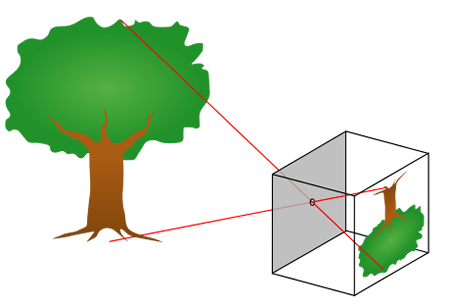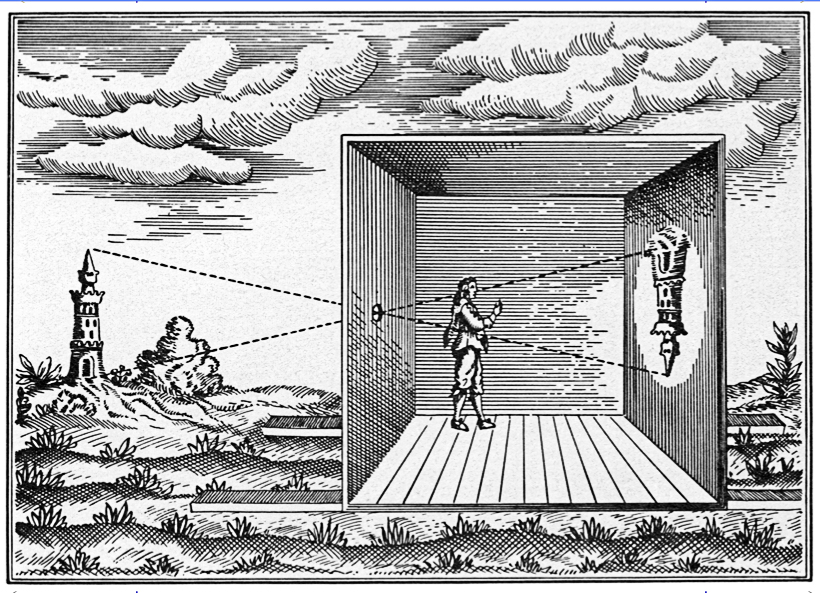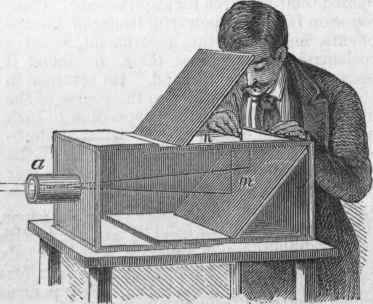| Assignment Day | Monday, June 05, 2016 |
| Due Date | Friday, June 17, 2016 5 PM. |
[H3] Build a Camera: Camera Obscura
Figures: A 17th century camera obscura illustration (on left, and right), Wikipedia "pinhole camera" middle).
Overview:
You will turn a room, tent (or any other place you can control) into a camera obscura (or pinhole camera) by letting light pass into the room only through a small small hole, the size of a pinhole.
An image of the outside world will then be projected upside-down onto a wall in your room -- it should be dim (and it may appear .very. dim), but should still be visible to the naked eye. In order to create a visual it is essential that you can make the room (of obscura) dark, and as dark as as possible.
To aid in the 'darkening process', we suggest you use tinfoil to black out all light sources other than your pinhole. The room needs to be very dark and the hole (pinhole) very small. The object of interest (on the outside of you camera obscura), the outside scene that you are capturing should be very bright. For each image that you create with your camera obscura:
(1) Take a digital photograph of the scene outside window (on the other side of the pinhole) that you are trying to capture (let's call it the "Scene").
(2)
Take a digital photograph of the image being projected onto your wall by your camera obscura (let's call it the "Image"), be sure that you are using a very long exposure (for example, 15 seconds) in order for your device to 'see' the image.
Be sure to keep the digital camera still during the entire exposure time (use/borrow a tripod! or put it on a table, prop it up, make the camera still, very still).
You are allowed to do some editing/enhancement to make this image more viewable (to adjust contrast, light, shadows, exposure, and use gimp -- free or, Photoshop not free ). If you do make enhancement please describe the steps in your report.
Take an image (or a series of images as appropriate) of the setup (the room, the subject), (call this the "Setup"). You may use use a DSLR for this part.
Part of your task is to experiment to get the best setup. It may involve attempting a variety of things in terms of how to control the light in the room. If your walls have dark paint, try holding up a white sheet of paper closer to the pinhole to reveal the image. If you feel your room or camera absolutely won't work for this task, then look for a different room.
Requirements:
You will need to make your 'own' camera obscura and should not use an existing 'modern' camera enabling capturing the seen. Capturing will need to be made by your camera obscura that is 'home made', no 'modern' camera capturing devices.
You should create at least 2 different scenes for you camera obscura.
What to Turn in:
A pdf named <lastname>_<firstname>.pdf : Example: Hybinette_Maria.pdf. The pdf at the minimum should have images (and a description) of each of the scenes you created with your camera obscura.
* THE scenes created by you built camera obscura, and a description of each of the scene (at least 2).
* THE scenes created by your 'professional' camera (for comparison)
* Set up images
* Answers to questions (see below).
Questions:
1. What site did you choose for your camera obscura experiment?
2a Why was it (your site) appropriate? (if you did multiple sites, describe what you learned from each site).
2b. What did you do to make it appropriate (or make it more 'capture-able')?
3. Was the image visible to naked eye?
4. Who helped you with this assignment? In what way? (this will address the GT Honor Pledge).
Rubric (may be refinements on this):
Minimally 2 scenes:
30 pts --- Series of Images of “Scene” captured by you camera obscura (15 pts each scene).
10 pts --- Capture of the
scene by your camera not camera obscura. (5 pts each scene).
20 pts --- Set up images by your camera (not camera obscura, and narration), (10 pts each scene)
10 pts --- Q/A What site did you chose discussion. (5 pts each scene)
30 pts --- Q/A Why was this an appropriate scene, did it stand out, is it visible?
(15 pts each scene)
Ideas and Links:
http://thedelightsofseeing.blogspot.com/2010/10/pinhole-photography-and-camera-obscura.html https://en.wikipedia.org/wiki/Pinhole_camera
http://www.reframingphotography.com/content/camera-viewer
Acknowledgement(s):
Project description courtesy Jay Summet and Irfan Essa.



